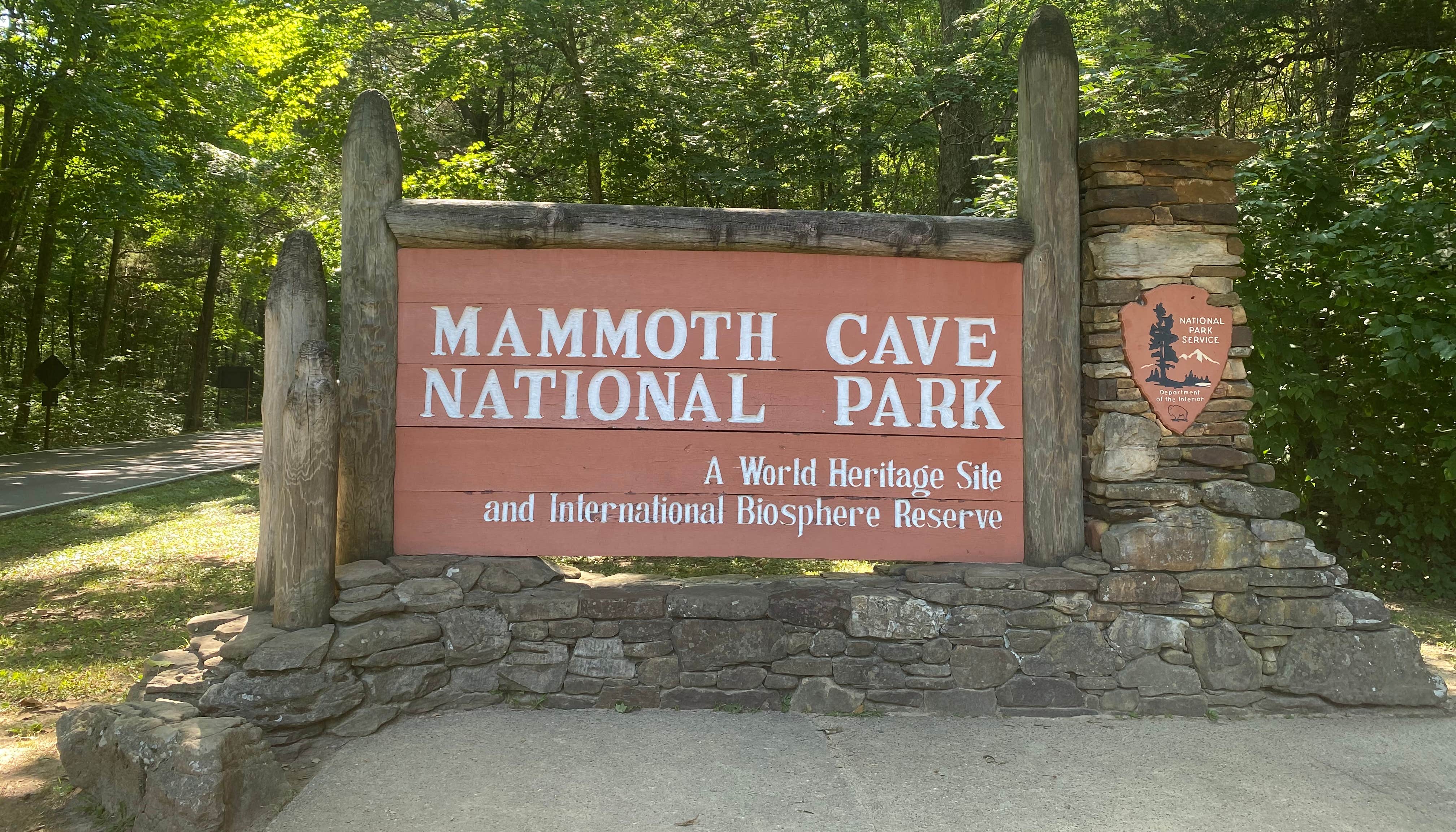Mammoth Cave National Park Camping Guide
Mammoth Cave National Park offers a unique camping experience where dense Kentucky woodlands hide the world's longest cave system beneath your tent. Three frontcountry campgrounds and numerous backcountry sites cater to everyone from RV travelers to paddlers on the Green River. Each camping area provides a different slice of the park: the main campground sits by the visitor center for easy cave tour access, a group camp welcomes equestrians north of the river, and a tiny riverside campground offers solitude. Beyond the park boundaries, private campgrounds with family-friendly amenities and lakeside sites add even more options. This comprehensive guide covers everything you need to plan and enjoy camping at Mammoth Cave National Park -- from snagging reservations and packing wisely to exploring trails, rivers, and of course the famous Mammoth Cave itself.
Mammoth Cave National Park Camping at a Glance
All Mammoth Cave campgrounds accept reservations during the main season (spring through fall), which open up to 6 months in advance on Recreation.gov. While Mammoth Cave Campground and Maple Springs Group Campground are closed in winter, Houchin Ferry Campground remains open year-round for hardy off-season tent campers. For 2025, note that the Green River Ferry (connecting the visitor center area to Maple Springs) is temporarily closed for repairs -- expect a 45-minute detour by road to reach north side campgrounds.
Nightly campsite fees range from $20 to $50 depending on campground and amenities. Standard tent sites at Mammoth Cave Campground cost $25 per night, primitive riverside sites at Houchin Ferry run $20, and group sites or those with hookups (water & electric at Maple Springs) are $50. The park does not charge an entrance fee, though cave tours require separate tickets (generally $8--$25 per adult). Most campgrounds open from March 1 to late November, with peak visitation in summer when cave tours are most popular. Summer days reach the high 80s °F with humid conditions, while winter days average in the low 40s °F with occasional freezing nights.
Mammoth Cave National Park Campground Quick Facts
| Quick Facts | Details |
|---|---|
| Number of Campgrounds | 3 developed campgrounds (Mammoth Cave, Maple Springs, Houchin Ferry) within park; 13 designated backcountry campsites |
| Total Campsites | Approximately 130 frontcountry sites (111 at Mammoth Cave, 7 group sites at Maple Springs, 12 at Houchin Ferry) + 13 primitive backcountry sites |
| Campsite Costs | $20 per night at Houchin Ferry (tent only) $25 per night at Mammoth Cave (standard site) $40--$50 per night group or hookup sites |
| Reservation Platform | Recreation.gov for all park campgrounds and backcountry permits (6 months advance booking window) |
| Camping Season | Main season: March 1 -- Nov 29 for Mammoth Cave & Maple Springs Houchin Ferry open year-round (primitive) |
| Temperature Ranges | Summer: Days 85--90°F, Nights 60--70°F Winter: Days 40--50°F, Nights 20--30°F |
| 2025 Updates | Green River Ferry closed for upgrades -- driving detour required to Maple Springs area All campgrounds requiring advance reservations (no first-come sites during peak season) |
Mammoth Cave Campgrounds: Complete Guide
Frontcountry Campgrounds
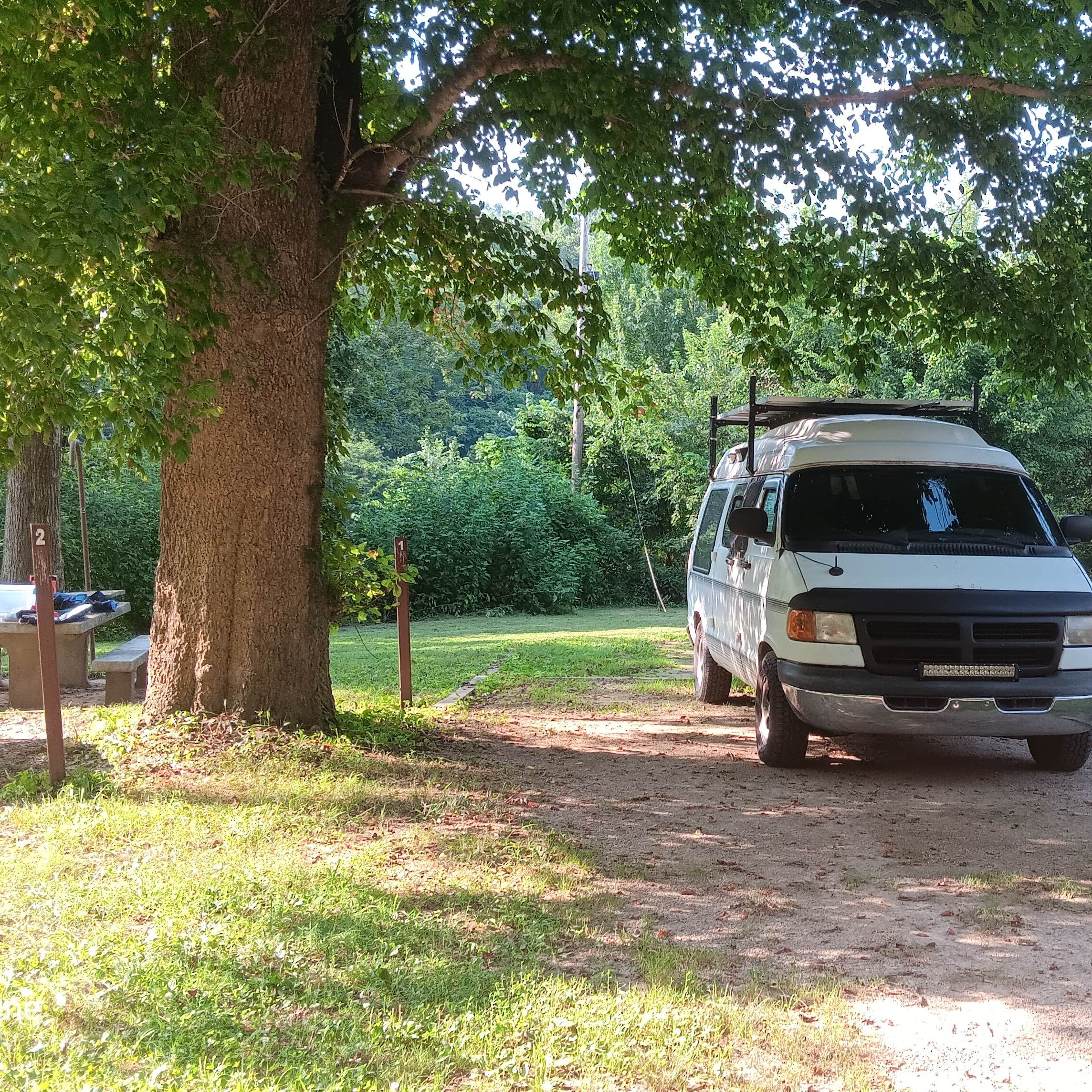
Houchin Ferry Campground — Mammoth Cave National Park
Houchin Ferry Campground offers primitive riverside camping along the Green River about 15 miles from the park's visitor center. Its 12 tent-only sites line a small loop under sycamores and willows, each with a picnic table and fire ring. Vault toilets and drinking water spigot are available year-round, but there are no electrical hookups or dump stations (RVs/trailers are not permitted due to narrow access). What Houchin Ferry lacks in amenities, it makes up for in tranquility -- campers often have views of mist rising off the Green River at dawn. Fishing is steps away from your tent, and a canoe launch is adjacent. The campground rarely fills except on holiday weekends, making it a good option for last-minute trips or fall/winter camping (when it operates first-come, first-served). Bring all supplies; the nearest town (Brownsville) is 2 miles away.
Backcountry & Dispersed Camping in the Park
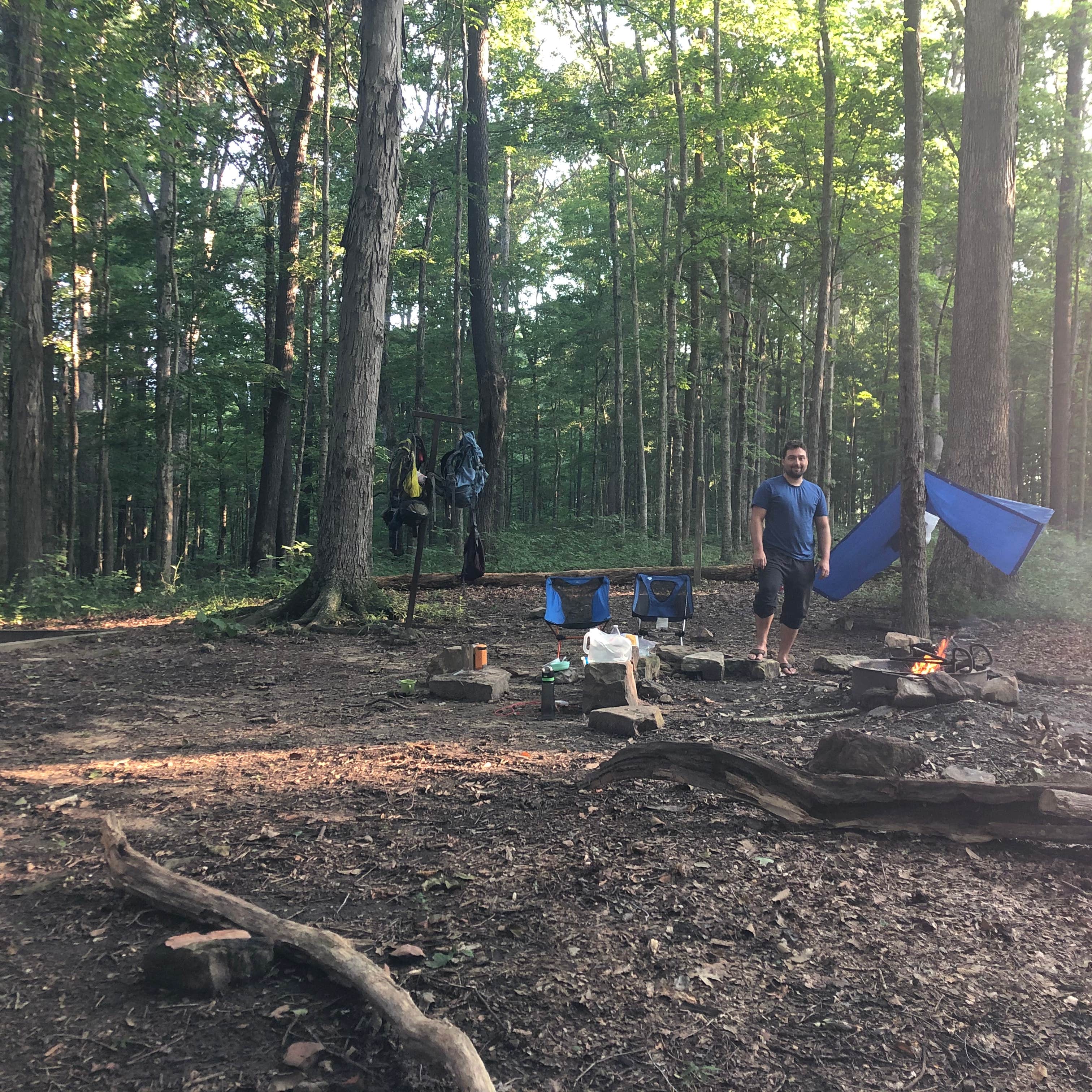
Turnhole Backcountry Campsite — Mammoth Cave National Park
Turnhole Bend Backcountry Site sits deep in the forest near a remote bend of the Green River. This hike-in campsite (about 2.5 miles via trail from the Maple Springs trailhead) is one of 13 designated backcountry sites in the park. It offers a flat clearing for tents, a fire ring, and a hitching post for horses. There is no treated water -- a small stream or the river must be filtered or boiled. The reward for the hike is seclusion: Turnhole Bend is known for its peaceful river views and night skies unobstructed by light. It's a favorite for backpackers seeking solitude or paddlers who camp after a day of canoeing (a backcountry permit is required). Expect wildlife like owls and foxes at night, and be prepared to pack out all trash.
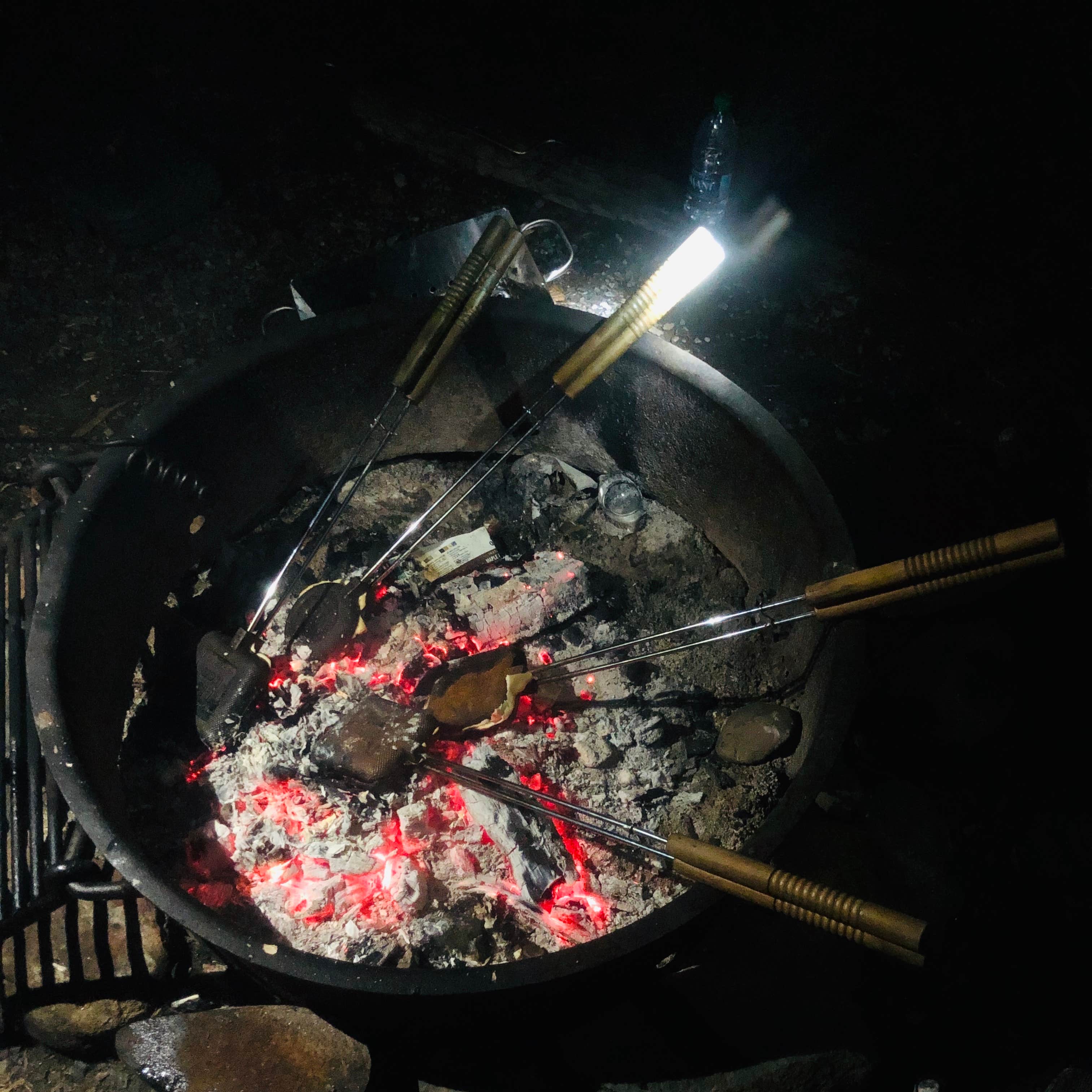
First Creek Dispersed Camping — Mammoth Cave National Park
First Creek Lake Dispersed Sites are a set of primitive camps along the First Creek drainage on the north side of the park. Reached by a 2.5-mile downhill hike on the First Creek Trail, these sites are near a small pond and the Green River. There are two marked sites (First Creek 1 and 2), each with a fire ring and space for a few tents. Water is available from the lake or river (treat before drinking). These sites offer a true backcountry experience -- expect quiet woods, possibly frogs calling from the water, and very few fellow campers. The hike out is uphill, so plan accordingly. Backcountry permits (free or $10) are required and available online or at the visitor center. These spots are perfect for adventurous campers or those looking to combine backcountry camping with fishing or kayaking on the river.
Campgrounds Near Mammoth Cave National Park
Outside the park, several private campgrounds and recreation areas provide additional camping options with more amenities or different scenery. Here are some top-rated picks within a short drive of Mammoth Cave:
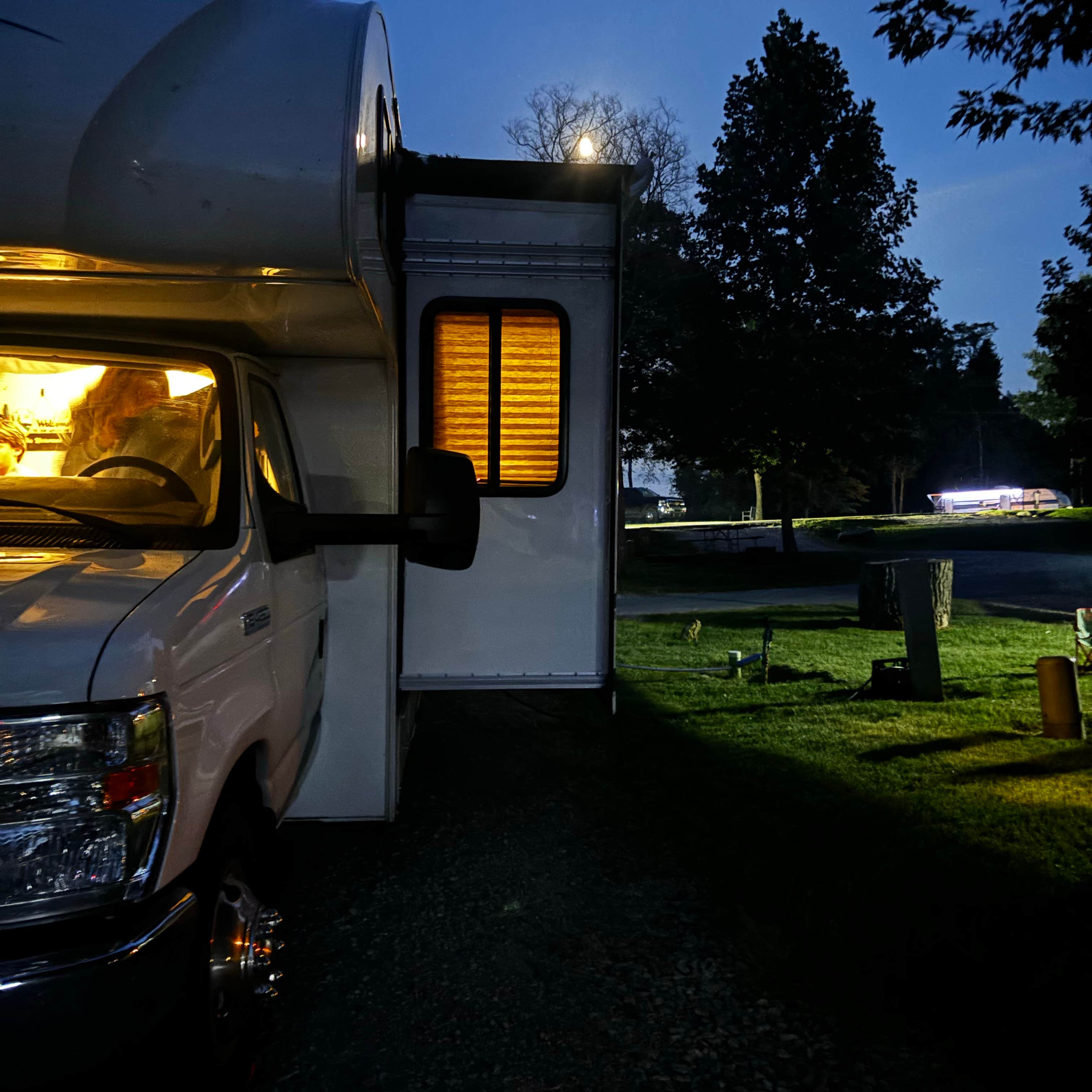
Jellystone Park at Mamoth Cave
Jellystone Park at Mammoth Cave (Yogi Bear's Jellystone Park) is a family-oriented campground located in Cave City, about 5 miles from the national park. This full-service resort features over 200 campsites (from tent spots to full-hookup RV sites) plus cabins. Kids love the on-site water park with splash pads and pools, mini-golf, playgrounds, and daily activities with Yogi Bear characters. Amenities include a camp store, snack bar, laundry, modern bathhouses, and Wi-Fi. Campsites are generally level and shaded by tall pines, with picnic tables and fire rings. Even with the resort atmosphere, quiet hours are enforced for a good night's rest. Jellystone is ideal for families who want entertainment for the kids after cave tours -- it's like a campground and amusement park combined.
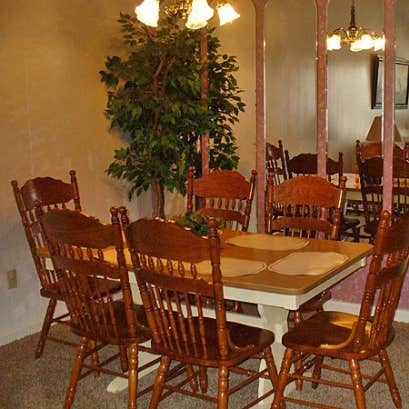
Thousand Trails Diamond Caverns RV & Golf Resort
Diamond Caverns RV Resort & Golf sits on the edge of the park near Park City (off I-65), about 11 miles from the visitor center. Part of Thousand Trails, this large campground offers 120+ RV sites (all with full hookups) and some tent sites, alongside a 18-hole golf course. Sites are a mix of pull-through and back-in, on gravel or concrete pads, with decent spacing and shade from mature trees. The resort boasts a seasonal pool, playground, dog park, camp store, and bathhouses with showers. Campers praise the friendly management and clean facilities -- the bathrooms and showers are kept air-conditioned in summer. With its golf course and amenities, Diamond Caverns provides a relaxing 'base camp' for exploring Mammoth Cave by day and unwinding in comfort by evening. It's open year-round and also offers rental cabins.
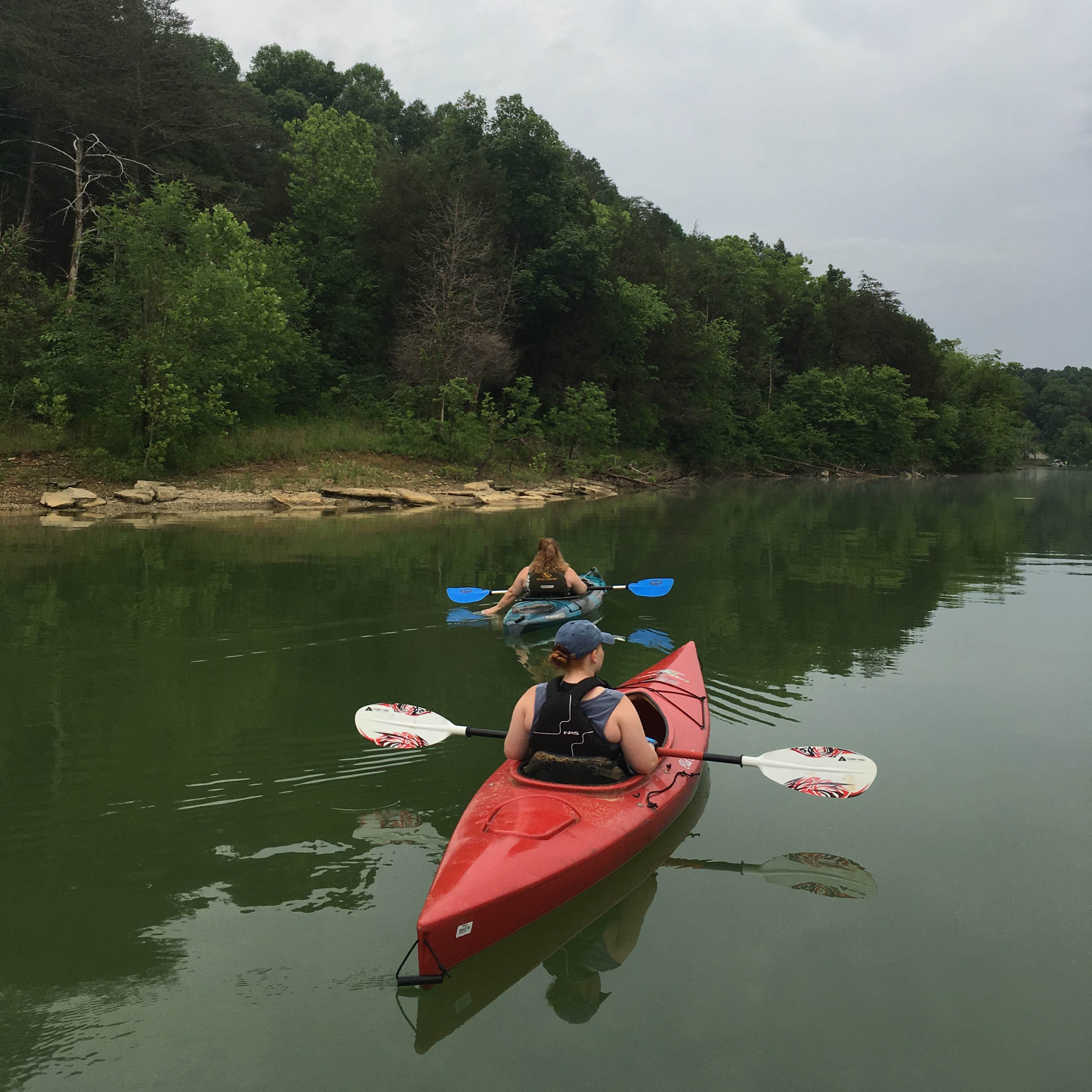
Dog Creek Campground
Dog Creek Campground is a scenic public campground on Nolin River Lake, about a 25-minute drive west of Mammoth Cave. Operated by the Army Corps of Engineers, Dog Creek features 70 campsites (most with electric hookups) spread along a lakeshore bluff. Many sites offer direct water views or access -- great for fishing or launching kayaks. Facilities include flush restrooms, showers, a boat ramp, playground, and swim beach. The campground is known for being clean and quiet, with friendly volunteer hosts. Sites are spacious and mostly level, with a mix of sun and shade. Dog Creek makes a nice combo trip for those who want to explore Mammoth Cave but also enjoy lake activities. Note that it is typically open mid-April through late September. Reservations are recommended in summer when lake campers fill the sites.
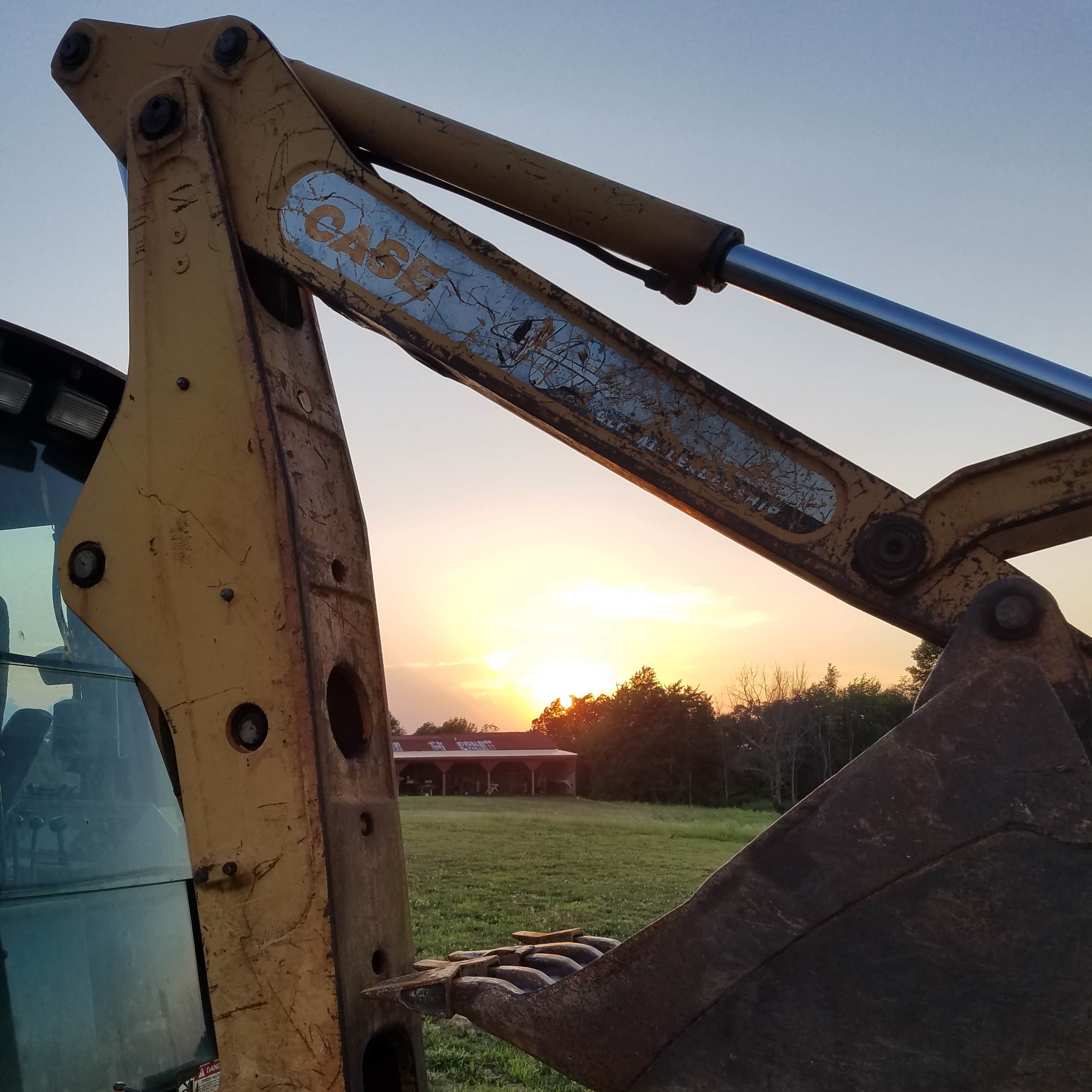
Mountain top retreat
Mountain Top Retreat (Cabins & Campground) is a privately owned hilltop campground in Cave City, roughly 4 miles from the park. Perched on a ridge, it offers a handful of full-hookup RV sites and tent sites alongside cabin rentals -- all with panoramic views of the wooded hills. The campground is small and relatively new, featuring amenities like clean bathhouses, a playground, and a camp store. Campers note the sites are well-maintained and the owners are attentive. This is a quieter alternative to the larger campgrounds, though it does come at a higher price point (tent/RV sites are around $40--$50). It's a good fit for visitors who prefer a calm setting and don't mind paying a bit more for privacy, views, and proximity to both the park and Cave City attractions (like zip-lining and museums).
Mammoth Cave Campground Comparison Table
| Campground | Location & Sites | Cost & Reservations |
|---|---|---|
| Mammoth Cave | Main Visitor Center area 111 sites (tent & RV) | $25 standard; $50 hookup Recreation.gov (Mar--Nov) |
| Maple Springs | North of Green River 7 group/equestrian sites | $50 per site Recreation.gov (Mar--Nov) |
| Houchin Ferry | Green River south bank 12 tent sites | $20 per site Recreation.gov (year-round; off-season FCFS) |
| Jellystone Park | Cave City (5 mi east) 200+ sites, cabins | $40--$80 (varies by site type) Call/Website (Private) |
| Diamond Caverns RV | Park City (near I-65) 100+ RV sites, some tent | $45--$60 Thousand Trails or on arrival |
| Dog Creek (COE) | Nolin Lake (west side) 70 sites (electric available) | $18--$30 Recreation.gov (Apr--Sep) |
Campground Amenities and Best Uses
Mammoth Cave Campground (Main): Best for easy cave access and amenities. It's walking distance to visitor center cave tours and has the most facilities (water, flush toilets, showers nearby). Ideal for families and first-time visitors who want convenience. Sites are wooded but close together -- expect to see neighbors. Arrive early for check-in as this campground is the park's busiest in summer.
Maple Springs (Group & Horse): Best for group gatherings, Mammoth Cave National Park equestrian camping, and quiet retreats. With its spacious group sites and horse-friendly setup, it's perfect for Scout troops, church groups, or riders exploring backcountry horse trails. Individuals can book it too -- you'll enjoy peace on non-weekends. Just plan for the extra drive (or ferry crossing) to reach it. There are no crowds here, even when the main campground is full.
Houchin Ferry (Primitive): Best for tent campers seeking solitude, anglers, or late planners. This tiny campground rarely fills and offers a rustic experience by the river -- great for fishing at dawn or launching a kayak. It has very basic amenities, so come self-sufficient (bring firewood, lanterns, etc.). Use Houchin Ferry as a base if you want to mix cave tours with paddling the Green River or if you're camping in the quieter off-season months.
Private & Nearby Options: Jellystone Park is tops for families who want non-stop entertainment (water park, playgrounds) in addition to visiting the caves -- kids won't get bored. Diamond Caverns RV Resort suits those with big rigs or golfers looking for extra comfort (full hookups, pool, golf course on-site) while still being close to the park. For lake enthusiasts, Dog Creek on Nolin Lake offers swimming and boating -- a nice combo with a Mammoth Cave trip. Mountain Top Retreat provides a cabin-like atmosphere and sweeping views, catering to campers who prioritize scenery and don't mind a more premium campground experience.
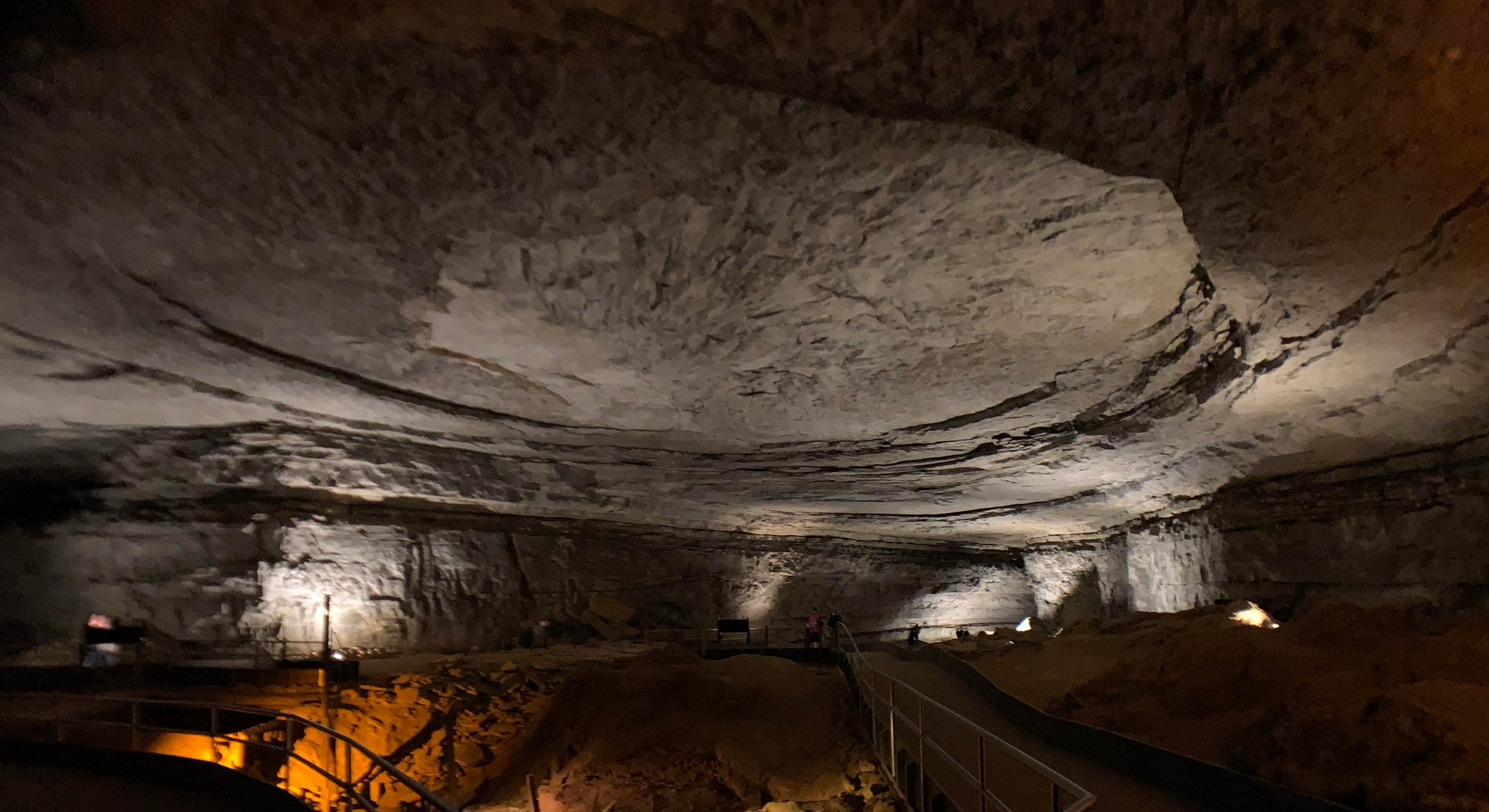 Photo by Jason J
Photo by Jason J
Planning Your Mammoth Cave Camping Trip 
When to Visit Mammoth Cave
Like many parks in the region, Mammoth Cave experiences four distinct seasons. The cave itself remains a constant ~54°F year-round, but surface conditions vary significantly. Here's what to expect each season for camping:
| Season | Temperatures | Camping Conditions |
|---|---|---|
| Spring (March--May) | Days: 60--75°F Nights: 40--50°F | Wildflowers blooming, frequent rain Campgrounds open by March/April, moderate crowds |
| Summer (June--August) | Days: 85--90°F Nights: 65--70°F | Hot, humid weather Peak visitation -- reservations essential Full cave tour schedule |
| Fall (September--October) | Days: 70--80°F (Sep) to 60s°F (Oct) Nights: 40--55°F | Comfortable days, crisp nights Fall foliage mid-October Campgrounds close late Oct (except Houchin) |
| Winter (November--February) | Days: 40--50°F Nights: 20--30°F | Off-season tranquility Mammoth & Maple Springs closed (Houchin open year-round) Limited cave tours and facilities |
Spring (March--May):
Spring brings mild weather and new life to the park. By late March, redbuds and dogwood trees bloom along trails. Days reach the 60s or low 70s °F, but nights can still be chilly (40s°F). Rain is common -- pack a quality rain jacket and tarp for your campsite. Campgrounds usually open by early March for Mammoth Cave Campground and by April for Maple Springs. Crowds are lighter than summer, making this a great time for a peaceful trip (aside from a possible spike during spring break weeks). Cave tours run on a spring schedule -- popular tours may sell out on weekends, so consider reserving those in advance.
Summer (June--August):
Summer is peak season at Mammoth Cave. Warm, muggy days in the 80s or low 90s °F are the norm on the surface, but the cave offers a natural air-conditioning break at 54°F. Campgrounds are fully open and will be near capacity daily -- reserve campsites as early as possible (up to 6 months ahead). Afternoon thunderstorms pop up frequently; having a canopy or retreating to the cave during rain isn't a bad idea. Plan cave tours for the heat of the day and enjoy mornings/evenings for hiking or campfire time. Be prepared for insects (mosquitoes and ticks are active -- bring repellent). Despite the crowds and bugs, summer offers the most activities: extended cave tour schedules, canoe rentals on Green River, and evening ranger programs at the amphitheater.
Fall (September--October):
Fall might be the park's best-kept secret. Early fall retains summer's warmth but with fewer visitors once school is back in session. By mid-September, daytime highs drop into comfortable 70s°F, and nights in the 50s°F mean great sleeping weather. Fall foliage typically peaks in mid to late October -- the hardwood forests blaze with yellows and reds, making for beautiful hikes (try Green River Bluffs Trail for views). Most facilities and tours remain available through October. Campgrounds start closing in late October (Mammoth Cave Campground usually mid-Oct; Maple Springs end of Oct), but Houchin Ferry remains open. Layer up for the wider temperature swings and enjoy the quieter trails. Autumn is also a prime time for wildlife---deer are very active during the rut and often seen near camp at dawn.
Winter (November--February):
Winter is off-season for surface activities, but Mammoth Cave still offers cave tours year-round. Camping is limited to Houchin Ferry Campground in winter (primitive conditions) after the main campgrounds close in late November. Expect cold nights well below freezing at times (20s°F are common, occasionally teens). Snow is infrequent and light, but frost and cold rain occur. If you're prepared with a four-season tent, warm sleeping bag, and cold-weather gear, you can enjoy near-solitude. The rewards include stark, quiet forests and clearer night skies. Keep in mind that most park roads and trails remain open, and you can day-hike without summer's crowds or bugs. Just check ahead for any winter cave tour schedule changes and pack plenty of extra blankets and a thermos of something warm for those winter evenings by the campfire.
Mammoth Cave Reservation Systems Explained
Securing campsites at Mammoth Cave is straightforward since all park-operated campgrounds use Recreation.gov for reservations. There's no separate concessionaire system to navigate. Here are the key points:
Frontcountry Campgrounds (Recreation.gov): Mammoth Cave Campground, Maple Springs Group Camp, and Houchin Ferry Campground all accept advance reservations on Recreation.gov. The booking window opens 6 months in advance of your arrival date. Mark your calendar -- popular summer dates (especially weekends and holidays) can fill quickly, particularly for Mammoth Cave Campground. Create a Recreation.gov account beforehand and have flexible date options if possible. You'll pay the nightly fee online when reserving. Once peak season winds down (usually November), Mammoth and Maple Springs close, but Houchin Ferry becomes first-come, first-served (with self-pay stations) for winter.
Backcountry Permits: A free or low-cost permit is required for all backcountry (hike-in or paddle-in) camping in the park. You can obtain permits on Recreation.gov (search for "Mammoth Cave backcountry permit") or in person at the visitor center up to a week in advance. The permit system ensures backcountry sites aren't over capacity. There is a $10 fee per trip (covering up to 14 days and multiple sites). Unlike frontcountry sites, you don't reserve a specific backcountry campsite online -- you'll list your planned sites on the permit. Only one group is allowed per site per night, so have alternates in mind in case others are heading to the same spot.
For all reservations, cancellations can open up spots -- if you missed out on your ideal campground, keep checking Recreation.gov in the days before your trip. Also note that cave tour reservations are separate but strongly recommended in summer (they're booked via Recreation.gov or phone). Plan your cave tour times such that they mesh with your camping check-in/checkout; campground quiet hours won't interfere with morning cave tours if you're respectful with packing up.
Mammoth Cave NP Campground Costs and Budgeting
Camping in Mammoth Cave is quite affordable, especially compared to lodging in the area. Here's a breakdown of typical campsite fees and what you get:
| Campground Type | Nightly Cost | Key Features |
|---|---|---|
| Primitive Sites (no hookups) | $20--$25 | Houchin Ferry ($20) -- basic tent site, vault toilet Mammoth Cave standard ($25) -- tent/RV, water & flush toilets nearby |
| Group/Hookup Sites | $40--$50 | Maple Springs group or horse camp ($50) -- up to 16 people, water/electric Mammoth Cave RV hookup sites ($50) -- water/sewer/electric, only 2 available (FCFS winter) |
| Private Campgrounds | $30--$80 | Jellystone Park ( Diamond Caverns ( |
Additional Costs and Budget Tips
Park Fees: Good news -- there is no entrance fee for Mammoth Cave National Park. You can drive in and use the trails, picnic areas, and campgrounds freely. The primary park expense is cave tour tickets, which range from about $8 (short tours or children's tickets) up to $25 for adult tickets on longer specialty tours. If you plan multiple cave tours or other activities (like horseback riding tours, canoe rentals, etc.), budget those in accordingly.
Campground Extras: At the main campground, showers are available behind the Caver's Camp Store for a fee (usually around $3--$4 for a 10-minute hot shower -- purchase tokens at the store). Firewood is sold at the camp store as well (typically $6--$7 per bundle). Due to an invasive insect quarantine, do not bring your own firewood from out of state -- either buy it on site or gather any dead/down wood in the park (allowed). Ice, basic groceries, and even breakfast items can be bought at the camp store or nearby Mammoth Cave Hotel, though prices may be a bit higher than outside the park.
Fuel and Supplies: The closest town with full services is Cave City (about 15 minutes away), where you'll find gas stations, a grocery store, and restaurants. Gas in this area is reasonably priced, but topping up outside tourist centers can save a little. If you forget gear, there is an outdoor outfitter in Cave City and a Walmart about 20 minutes away (in Glasgow). Stocking up before entering the park will generally be cheaper than relying on the limited selection at the camp store.
Budget-Friendly Camping: If park campgrounds are booked or you want to save money, consider the nearby Tailwater Campground (an Army Corps campground below Nolin Lake Dam) -- it offers sites around $20 and is usually less crowded, about 25 minutes from the cave. Another free option is dispersed camping in the national forest to the east of the park (DNF in segments of the Mammoth Cave NRRA); however, sites aren't developed and you must be at least 0.5 mile from roads. For most visitors, the $20--$25 park campsites offer the best value given the location and facilities.
Finally, note that America the Beautiful passes (National Parks annual pass) do not apply to cave tours or camping fees here, since there's no entry fee -- but if you're heading to other parks on your trip, it could save you money elsewhere.
Essential Gear for Mammoth Cave Camping
Packing smart will ensure you stay comfortable in the variable climate and ready for cave adventures. Here are the must-haves and helpful gear, broken down by category:
Shelter and Sleeping:
- Tent with rainfly and footprint -- Spring and fall rains can be heavy, and a fitted ground tarp will keep you dry.
- Sleeping bags rated for ~10--20°F cooler than expected temperatures. (Summer nights can still dip into the 60s°F, and spring/fall nights into 40s°F.)
- Sleeping pad or air mattress -- the ground is limestone and can be hard/cold; an insulated pad improves comfort.
- Extra blankets or a liner if you're camping in early spring or late fall when nights get chilly.
- Headlamp or flashlight for each camper -- not only for nighttime restroom trips, but also handy on cave tours (you'll often want light when the tour guide turns off the lamps to show total darkness!).
Camp Kitchen:
- Cooler with ice -- Summer heat and no electricity at sites means you'll want a sturdy cooler. Cave City stores sell ice, or freeze gallon jugs.
- Camp stove and fuel -- Firewood fires are great for s'mores, but a propane stove is easier for cooking meals (and during wet weather when wood won't cooperate).
- Biodegradable soap, wash basin, and quick-dry towels -- Camp sinks aren't available, so you'll do dishwashing at your site. Strain food scraps and dispose of greywater at utility sinks or 200 feet from streams.
- Food storage solution -- Raccoons are the "bear" of Mammoth Cave. Bring a large plastic bin or dedicated cooler that can latch shut to store food, or use your vehicle. (There are no bear lockers since black bears are not common here, but critters will raid any cooler left open.)
- Coffee maker or percolator if you need that morning fix -- no one wants a cave tour before caffeine!
Clothing and Footwear:
- Sturdy hiking shoes or boots -- Trails range from level boardwalks to muddy backcountry paths. Closed-toe shoes are also required on cave tours (for safety and to avoid tracking contaminants).
- Lightweight long pants -- Even in summer, consider pants for hikes to guard against ticks in tall grass and to have coverage in the cool cave environment.
- Moisture-wicking layers -- Humidity is high in summer; quick-dry shirts and socks will help. In cooler months, pack warm layers (fleece, beanie, gloves).
- Rain gear -- a poncho or rain jacket plus an extra tarp can be a lifesaver during sudden thunderstorms.
- Headnet or bug repellent gear (insect-proof clothing) -- for those sensitive to mosquito bites, late spring and early summer can have many bugs in low-lying areas near water.
Safety and Health:
- Insect repellent and tick prevention -- The park is known to have ticks in grassy areas. Bring EPA-approved repellent (and do tick checks each evening). Some campers treat clothing with permethrin before the trip as an added measure.
- First aid kit -- include basics like bandages, antiseptic, pain relievers, moleskin for blisters, and any personal medications. The remote campground locations mean it's 20+ minutes to the nearest clinic.
- Flashlights or lanterns -- beyond your headlamp, a good LED lantern for the picnic table helps with cooking and camp tasks after dark. The campgrounds get very dark at night (great for stargazing, challenging for late-night walks).
- Map and compass -- Cell service is spotty in the park (generally better on ridge tops, weak in valleys). Grab a park map at the visitor center so you can navigate the roads and trails without relying on your phone's GPS.
- Portable charger or spare batteries -- If you plan to use your phone for photos (cave pics can drain batteries with flash) or as a light, have backup power since electric outlets are only available at restrooms or not at all.
Cave Tour Gear:
- Small backpack or fanny pack -- handy for carrying water and a light jacket to the cave. Cave trails have plenty of stairs, so keep it light.
- Light jacket or hoodie -- even on a 90°F summer day, that 54°F cave will feel cool after an hour. Bringing a layer tied around your waist is wise.
- Sturdy shoes -- reiterating this: caves can have wet, slick surfaces. Your feet will thank you if you wear something with grip (sneakers or hiking boots, not flip-flops).
- Hand sanitizer or wipes -- cave restrooms are at the tour start; it's nice to clean up after crawling or touching cave railings (and before a campsite lunch).
Packing for a Mammoth Cave camping trip is about balancing above-ground comfort with below-ground exploration readiness. By preparing for both humid summer afternoons and the cool damp cave environment, as well as being ready for rain or shine, you'll ensure nothing puts a damper on your adventure underground or on the surface.
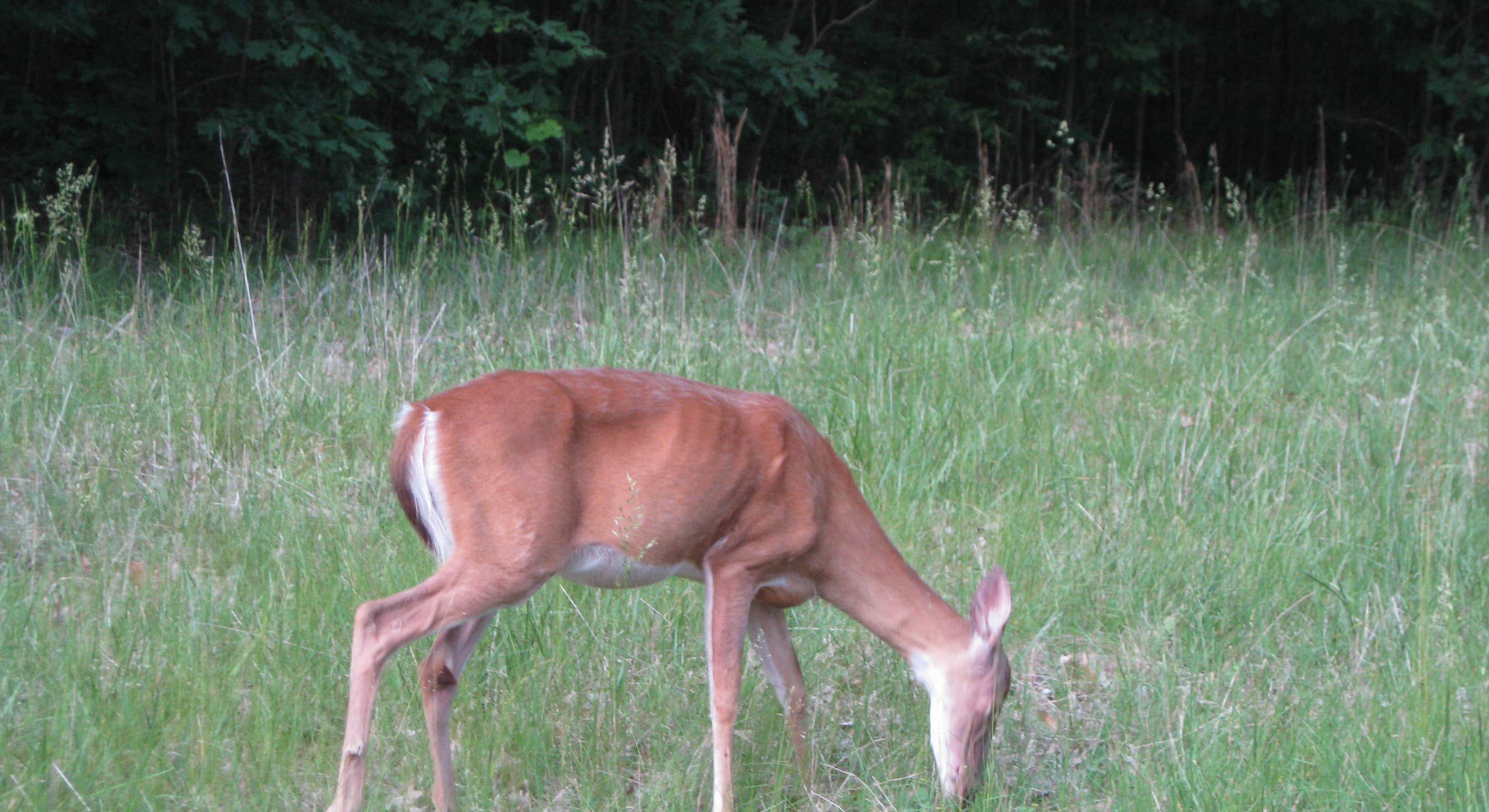
Wildlife Safety and Park Regulations 
Wildlife Safety in Mammoth Cave
Mammoth Cave National Park is home to many animals, but notably no resident bears (a relief for many campers!). However, you'll still need to store food properly and respect wildlife to avoid problems with smaller critters and protect the animals themselves:
Food Storage and Camp Visitors:
Even without bears, raccoons are extremely adept at raiding coolers and tents for food. Always secure all food, trash, and scented items (toothpaste, soap) in a locked vehicle or a sturdy cooler with clamps when you're away from camp or asleep. Do not leave coolers or food on picnic tables overnight. Raccoons at the campgrounds have learned that coolers mean easy snacks -- rangers often cite campers for leaving food unattended. Similarly, gray squirrels and chipmunks will chew through packs if they smell trail mix. In short, treat food storage almost as you would in bear country: "stash it or trash it" properly every time.
Insects and Bites:
The most persistent wildlife nuisance in warmer months are mosquitoes and ticks. Use insect repellent and consider wearing light long-sleeve shirts and pants in tick-prone areas (like along the backcountry trails or tall grass by Houchin Ferry). After hiking, do a thorough tick check -- especially kids and pets -- and carefully remove any ticks with tweezers. Mosquitoes are worst near water at dawn and dusk; a smoky campfire or a Thermacell device can help keep them at bay. Also be cautious of brown recluse spiders in woodpiles or restrooms -- shake out boots or gloves that have been on the ground before putting them on.
Snakes:
Kentucky is home to a few venomous snakes, and Mammoth Cave has copperheads (most common) and timber rattlesnakes (rare and shy). These snakes generally avoid busy camp areas, but you might encounter one on a quiet trail or near the river. Wear closed-toe shoes when walking at night and use a flashlight. Stick to established trails and watch where you put your hands and feet when climbing or stepping over logs. If you see a snake, give it distance and time to slither away -- do not attempt to handle or harass it. Bites are extremely rare and typically happen only if a snake is provoked or stepped on. The park has protocols for snake bite response (call rangers immediately if it ever happens). For perspective, you're much more likely to simply see non-venomous snakes like a black rat snake hanging out near the visitor center -- which can actually be a thrilling sight!
Larger Animals:
White-tailed deer are abundant. In autumn rut (October--November), bucks can be less fearful -- observe them from afar, especially if you see them sparring with antlers. Do not feed deer or any wildlife (it's illegal and harmful). You might also see wild turkeys strolling through camp or hear coyotes howling at night from across the valley. These animals won't bother you if you don't bother them. Keep a respectful distance (at least 25 yards from deer or turkeys) and secure your trash so none of them try to nibble on inappropriate foods.
Overall, by securing food, wearing proper attire against bugs, and giving any wild creature plenty of space, you'll have safe and enjoyable wildlife encounters. Many campers count softly hooting owls or the flash of fireflies as some of the best nighttime "wildlife" experiences in Mammoth Cave -- and those are perfectly safe to enjoy! For those bringing furry friends along, check out pet-friendly camping near Mammoth Cave National Park for sites that accommodate four-legged adventurers.
Park Regulations and Etiquette
| Regulation Category | Specific Rules | Penalties |
|---|---|---|
| Campfires | Allowed only in provided fire rings/grills Do not leave fires unattended Use only downed wood or purchased firewood (no out-of-state wood) | Ranger citation; possible fine You may be held responsible for any wildfire |
| Quiet Hours | 10:00 PM -- 6:00 AM in all campgrounds Generators permitted 8 AM -- 8 PM only (not at Houchin Ferry) | Verbal warning for first offense Repeat violations may result in eviction from campground |
| Wildlife & Pets | No feeding wildlife (includes leaving food scraps) Stay 25 yards from wildlife (100 yards from any rare bears) Pets must be leashed (max 6 ft) and attended at all times | Fines up to $200 for feeding or harassing animals Unleashed pets may result in citation or removal from park |
| Cave Protection | No touching cave formations Do not bring items into cave that have been in other caves (white-nose syndrome prevention) All cave tour participants must walk on disinfecting mats | Removing or damaging cave features is a federal offense with hefty fines Rangers may deny cave entry to those not complying with decontamination protocols |
Additional Mammoth Cave Park Regulations
Leave No Trace: The park asks all visitors to follow Leave No Trace principles. For campers, this means pack out all trash you bring in. Use the dumpsters and recycling bins at campground entrances -- do not burn or bury garbage. If you're in the backcountry, carry a zip-top bag for your trash and food scraps. Leave natural objects (rocks, antlers, etc.) where you find them for the next person to enjoy. Essentially, strive to leave your campsite and trails as clean or cleaner than you found them.
Waste Water: Do not dump dishwater or any greywater on the ground in campgrounds. Collect it in a container and take it to the utility sink (available at the restroom in Mammoth Cave Campground) or at least broadcast it well away from any water sources in backcountry (200 feet from streams). This prevents food residue from attracting wildlife and keeps the groundwater clean. Likewise, wash yourself or your dishes away from springs and streams -- even biodegradable soap can affect aquatic life.
Human Waste (Backcountry): If you're camping in the backcountry or kayaking and camping along the river, use the provided pit toilets where available (most designated backcountry sites have none, but some river access points do). If nature calls in a remote area, dig a cathole 6--8 inches deep at least 200 feet from water and trails, and cover it completely. It's prohibited to leave toilet paper or wipes on the ground -- pack them out in a sealed bag. The frontcountry campgrounds have toilets, so this is mainly for wilderness travelers.
Firewood Quarantine: As mentioned, the park prohibits bringing firewood from quarantine areas (many surrounding states) due to invasive insects like the emerald ash borer. Buy wood locally (within 50 miles) or use heat-treated packaged wood. Rangers can confiscate out-of-state wood and issue fines because one load of infested firewood can decimate the park's forests over time. Burn all your purchased wood or leave unburned pieces in the fire ring for the next camper (do not take it with you to another park).
Drone Use: For those interested in photography -- know that drones are not allowed anywhere in Mammoth Cave National Park. It's a National Park Service-wide rule to protect wildlife and visitor experience. Leave the drone at home and stick to capturing memories with handheld cameras.
By respecting these regulations and practicing good etiquette (like keeping noise down, yielding to others on narrow cave stairs, and being courteous with flashlight use in caves at night), you help ensure Mammoth Cave remains a pristine and pleasant place for everyone. Rangers do patrol campgrounds and trails, and they're friendly and happy to answer questions -- but they will enforce rules when needed to protect the park and its visitors.
Beyond the Campground: Activities and Exploration 
Day Trips from Mammoth Cave Campgrounds
From Mammoth Cave Campground:
Staying at the main campground puts you in the heart of park attractions. The Mammoth Cave Historic Entrance is only a 5-minute walk down the trail behind the adjacent visitor center -- perfect for joining a morning cave tour without worrying about parking. You can easily return to your site for lunch and be back for an afternoon cave tour or ranger talk. Above ground, hike the Heritage Trail from camp to Sunset Point (0.7 mi round-trip) for an overlook of the Green River valley, especially pretty at dusk. A short drive (5 minutes) takes you to the Sand Cave Trail, a quick walk to the famous cave where Floyd Collins was entombed in the 1920s -- a bit of park history. In summer, consider driving 10 minutes to the Green River Ferry crossing: even if the ferry is closed to cars, the riverside area is scenic and you might catch sight of turtles or otters along the riverbanks.
From Maple Springs (North Side):
If you're camping at Maple Springs, you're on the north side of Green River -- a quieter area rich with trails. Many of the park's longer day hikes start near this campground. A great half-day trek is the Buffalo Trail loop combined with the Sal Hollow Trail (access from Maple Springs Trailhead) -- you'll wander through upland forests and cross karst valleys, often without seeing another person. Equestrian campers can ride out on the Raymer Hollow Trail to see remote sections of the park. A notable short drive (15 minutes) from Maple Springs is to Cedar Sink -- a 2-mile round-trip hike into a huge sinkhole where a river pops in and out of the ground. It's one of the most impressive geological features above ground. Remember, if the Green River Ferry is running, you can be at the visitor center side in minutes; if not, the detour to park HQ is about 45 minutes, so plan your cave tour times accordingly.
From Houchin Ferry Campground:
Houchin Ferry's location lends itself to water-based adventures. Right from the campground you can launch a kayak or canoe and explore the Green River. A popular paddle is Houchin Ferry to Green River Ferry, which is about 12 miles downstream (you'd need a shuttle pickup, or just do an out-and-back). Fishing for bass and catfish is excellent near the campground -- try casting in the early morning or evening when the river is calm and fish are biting (Kentucky fishing license required). By car, you're only 2 miles from the town of Brownsville -- a good opportunity to grab an ice cream or visit the local grocery if you need supplies. For a short hike, drive 10 minutes to the Turnhole Bend Nature Trail: this easy 0.5-mile loop leads to an overlook of the Green River and the river's namesake "turn hole" (a deep blue spring pool) -- a beautiful spot to picnic. And if you want to do a cave tour, the visitor center is about 25 minutes drive; consider doing an afternoon tour, then treating yourself to a hot shower at the camp store before returning to your primitive riverside camp at Houchin Ferry.
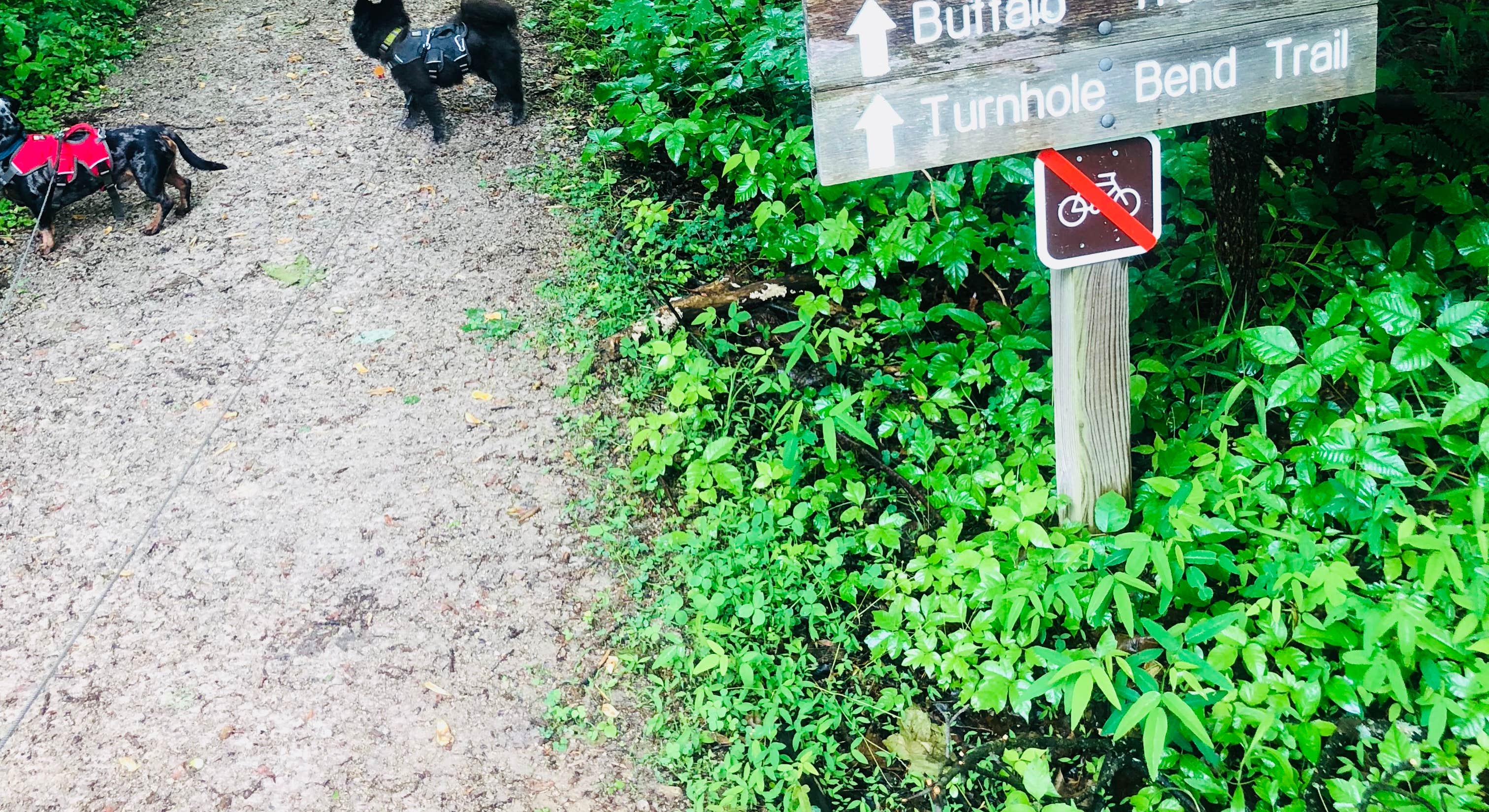 Photo by Shelly S
Photo by Shelly S
Top Hiking Trails Near Campgrounds
| Trail Name | Difficulty & Distance | Key Features |
|---|---|---|
| Cedar Sink Trail | Moderate 1.8 miles RT | Descends into a giant sinkhole, overlooks subterranean river emerging and disappearing, wildflowers in spring |
| Green River Bluffs Trail | Easy/Moderate 1.3 miles one-way (2.6 RT) | Scenic bluff-top views of Green River, connects visitor center to River Styx Spring, good birding |
| Heritage Trail | Easy (ADA accessible) 0.5 miles one-way | Paved path from campstore to Sunset Point, views of historic Mammoth Cave Hotel and sunset over valley |
| River Styx Spring Trail | Easy 0.4 miles one-way | Leads to the spot where the cave's River Styx emerges into Green River, lush vegetation, often cool on hot days |
| Sal Hollow Trail | Strenuous 8.6 miles one-way | Backcountry trail from Maple Springs into deep woods, sinkholes and hollows, very secluded (used by hikers & horses) |
Mammoth Cave NP Trail Access and Starting Points
From Visitor Center Area: Two of the best short hikes start right by the visitor center parking. Green River Bluffs Trail begins behind the campstore and winds 1.3 miles to an overlook above the river -- you can return via Dixon Cave Trail to make a loop. The Heritage Trail also starts near the campstore; it's fully accessible and leads to Sunset Point, making it great for an easy evening stroll to watch the sky glow over the forested ridges.
From North Side (Maple Springs): Access longer hikes from the Maple Springs Trailhead (near the group camp). Sal Hollow Trail and Buffalo Trail both depart from here -- since these are one-way trails deep into the backcountry, many hikers will do an out-and-back as far as they feel comfortable. For a shorter sampler, hike 2 miles down Sal Hollow to where it intersects the Critters Fork creek -- a pretty spot to turn around. Always carry a map on these north side trails; intersections with horse trails can be confusing.
From Houchin Ferry Area: There are no official hiking trails leaving Houchin Ferry Campground itself, but a short drive (2 miles) brings you to the Echo River Spring Trail at the Green River Ferry area (if the ferry is closed, access it via Brownsville Road). This .6-mile boardwalk trail leads to where Echo River (a cave river) surfaces, with interpretive signs explaining the underground rivers. It's an easy walk suitable for all ages and a nice add-on to a cave tour day. Also, the gravel road leading into Houchin Ferry Campground sees very little traffic -- some campers enjoy a peaceful walk along the river on this road at sunrise or dusk, listening for owls and watching mist on the water.
Fishing, Boating, and Water Activities
Mammoth Cave's rivers add an extra dimension to your camping trip -- whether you cast a line from shore or paddle along limestone bluffs, the Green and Nolin Rivers are integral to the park experience:
Fishing the Green & Nolin Rivers:
The park's rivers are known for excellent fishing, especially for smallmouth bass, channel catfish, and sunfish. Green River, which flows through the park for 25+ miles, offers lots of shoreline access near campgrounds -- popular spots include the riverside at Houchin Ferry (step out of your tent and fish at dawn!), the bank below Green River Ferry, and along First Creek near its backcountry sites. The Nolin River (a tributary) can be accessed at Nolin River Dam and tailwater area on the park's western edge for bass and crappie. Kentucky state fishing regulations apply -- you'll need a Kentucky fishing license (available online or at local stores) but no additional park permit. Bait like nightcrawlers or crickets works well for panfish, while artificial lures (spinnerbaits, soft plastics) are favored for bass. Remember to keep a respectful distance from swimmers or paddlers and pack out any fishing line or trash to keep the waterways pristine.
Canoeing and Kayaking:
Paddling the Green River is a highlight for many campers. This slow-moving river winds past cave-dotted bluffs, huge sycamore trees, and gravel bars perfect for picnics. Canoe and kayak rentals are available from outfitters in Cave City and Brownsville, who will also provide shuttle service. Popular routes include a 7-mile paddle from Dennison Ferry to Green River Ferry (about 3--4 hours) or the longer 12-mile trip from Green River Ferry down to Houchin Ferry (5--6 hours). If you have your own boat, you can put in at Dennison Ferry (primitive ramp), Green River Ferry, or Houchin Ferry and arrange a vehicle at the take-out. Always wear your life jacket (PFD) -- it's required by law when on park waters. Watch for wildlife as you glide: wood ducks, great blue herons, and the occasional river otter might be seen. During summer, start early in the day to avoid afternoon heat and possible thunderstorms. Paddling at Mammoth Cave offers a serene complement to the cave tours -- a chance to see the park's surface beauty and maybe even float over sections of cave beneath!
Swimming and Wading:
While there are no developed swimming beaches in the park, you can take a dip in the rivers to cool off -- cautiously. The Green River has a gentle current most of the year, but always assess conditions first (after heavy rains it can be swift and murky). A favorite swimming hole for campers is at the Houchin Ferry boat ramp, which has a gradual entry. Do not jump from any bluffs or trees, and be mindful that depths vary (there can be deep pools and submerged logs). Parents should keep children within arm's reach; using a PFD for young or less experienced swimmers is wise. Note that there are no lifeguards -- all water activities are at your own risk. Alternatively, if you crave a pool, Jellystone Park campground (if you're a guest) and the community pool in Cave City offer chlorinated options. One more water treat: on weekends in summer, rangers sometimes lead free canoe trips or river walks -- check the schedule, as these guided experiences can be fantastic for learning about the park's aquatic life.
Other Activities:
Boating with small motorboats is allowed on the Green River (max 10 HP motors), but most people stick to paddle-power due to the river's tranquil nature and occasional shallow riffles. If you're interested in spelunking beyond the main cave tours, consider the Wild Cave Tour offered by the park -- it's a 6-hour adventure spelunking off-trail (reservations and sturdy boots required). Above ground, biking is growing in popularity: the park has several gravel service roads and the Mammoth Cave Railroad Bike & Hike Trail (9 miles) that offer great rides -- you can even bike from the campground to Diamond Caverns along this trail. And in summer, the park often hosts evening programs at the amphitheater on topics like nocturnal animals or cave geology -- a nice way to wind down after dinner (check the bulletin boards for program schedules).
The Dyrt Community Insights 
Ranger Recommendations
The Dyrt's camping community and park rangers have plenty of insider tips for Mammoth Cave. Here are a few to consider as you plan:
Maple Springs "Hidden Gem":
Rangers often recommend Maple Springs Group Campground for those seeking a quieter experience. One ranger noted, "Maple Springs is underutilized -- if you don't mind the extra drive, you might have an entire loop to yourself on a weekday." The spacious sites and tall trees make it serene. It's especially recommended in fall, when the maple leaves turn golden and you can hear distant elk bugling from across Green River (yes, elk have been spotted just north of the park!). Just remember to bring everything you need; with the ferry out, you won't be zipping back to the store easily.
Best Campground for Families:
Experienced campers on The Dyrt unanimously point to Jellystone Park as the top family-friendly spot near the park. One Dyrt Ranger (super-user) wrote: "If you have kids, Jellystone is worth the cost. The water slides and pool kept them entertained all day after we did a morning cave tour." Rangers don't manage Jellystone, but even they hear positive feedback from visitors who stayed there. The takeaway: if you know your family will want more than hiking and caves (like playgrounds, foam parties, and ice cream), Jellystone at Mammoth Cave is a strong choice -- just reserve early for summer weekends.
Primitive Camping Tip:
For those looking to camp for free, The Dyrt community highlights a spot just outside the park: Lincoln Trailhead (in the national forest). It's a trailhead parking area off KY-1827 (north of the park) where dispersed camping is allowed. "Not much there but a fire ring someone built, but it's quiet and you can hike into the park on the Berry Cave Trail from camp," reports one reviewer. It's a good option if park sites are full. However, there are no facilities -- practice Leave No Trace. Inside the park, Houchin Ferry is the closest equivalent to free camping at $20; several users mention you can often show up without a reservation and still get a site there except on holiday weekends.
Top-Rated Mammoth Cave Campsites from The Dyrt Community
| Category | Top Pick & Rating | Key Highlights |
|---|---|---|
| Highest-Rated In-Park | Maple Springs 4.7/5 stars | Quiet, spacious group sites; electric hookups; easy access to horse & hike trails; very low light pollution at night |
| Best Private Resort | Yogi Bear's Jellystone Park 4.5/5 stars | Water park and pools, organized kids' activities, clean facilities, close to park (5 miles), cabins available |
| Best Waterfront Camping | Dog Creek (Nolin Lake) 4.6/5 stars | Lakeside sites with swimming area, great for fishing/boating, well-kept COE campground, less crowded than park campgrounds |
| Most Peaceful Primitive | Houchin Ferry 4.2/5 stars | Riverside tent camping, minimal amenities but beautiful river views, fantastic stargazing and wildlife sounds at night |
Mammoth Cave Community Insights and Recommendations
Under-the-Radar Hiking: Campers frequently mention the Sinkhole Trail (near Maple Springs) as an underrated short hike. "It's only about a mile loop but you pass at least four different sinkholes, one with a hidden cave entrance. We didn't see another person," writes one Dyrt user. So if you're at Maple Springs, give that a try for a quick morning walk.
Cave Tour Timing: The Dyrt community agrees that early cave tours are the way to go. By afternoon, the park can feel hot and humid, and you'll welcome the cave's air-conditioned climate. Plus, morning tours tend to be less crowded than the popular mid-day ones. One camper noted, "Our 9 AM Historic Tour had maybe 20 people. The noon tour we did next day was 60+ -- still fine, but mornings felt more intimate."
Local Cave Alternatives: If Mammoth Cave tours are sold out, The Dyrt users suggest checking out nearby caves like Diamond Caverns (right by the park, they have guided tours through stunning dripstone formations) or Hidden River Cave in Horse Cave, KY (30 min away, with a cave museum and underground boat tour). While not part of the national park, they are a fun supplement. Several campers reported really enjoying these smaller cave experiences with no reservation needed, then returning to their national park campground for the night.
Evening at the Amphitheater: Many reviewers loved the free evening ranger programs at Mammoth Cave Amphitheater (by the visitor center). Topics vary -- star gazing nights, bat ecology, cave legends -- but bring a camp chair or blanket and a flashlight for the walk back. As one Dyrt camper said, "Don't skip the night programs. Our kids got to see Saturn's rings through a telescope set up by a ranger. Then we walked back to camp under an incredible sky -- unforgettable."
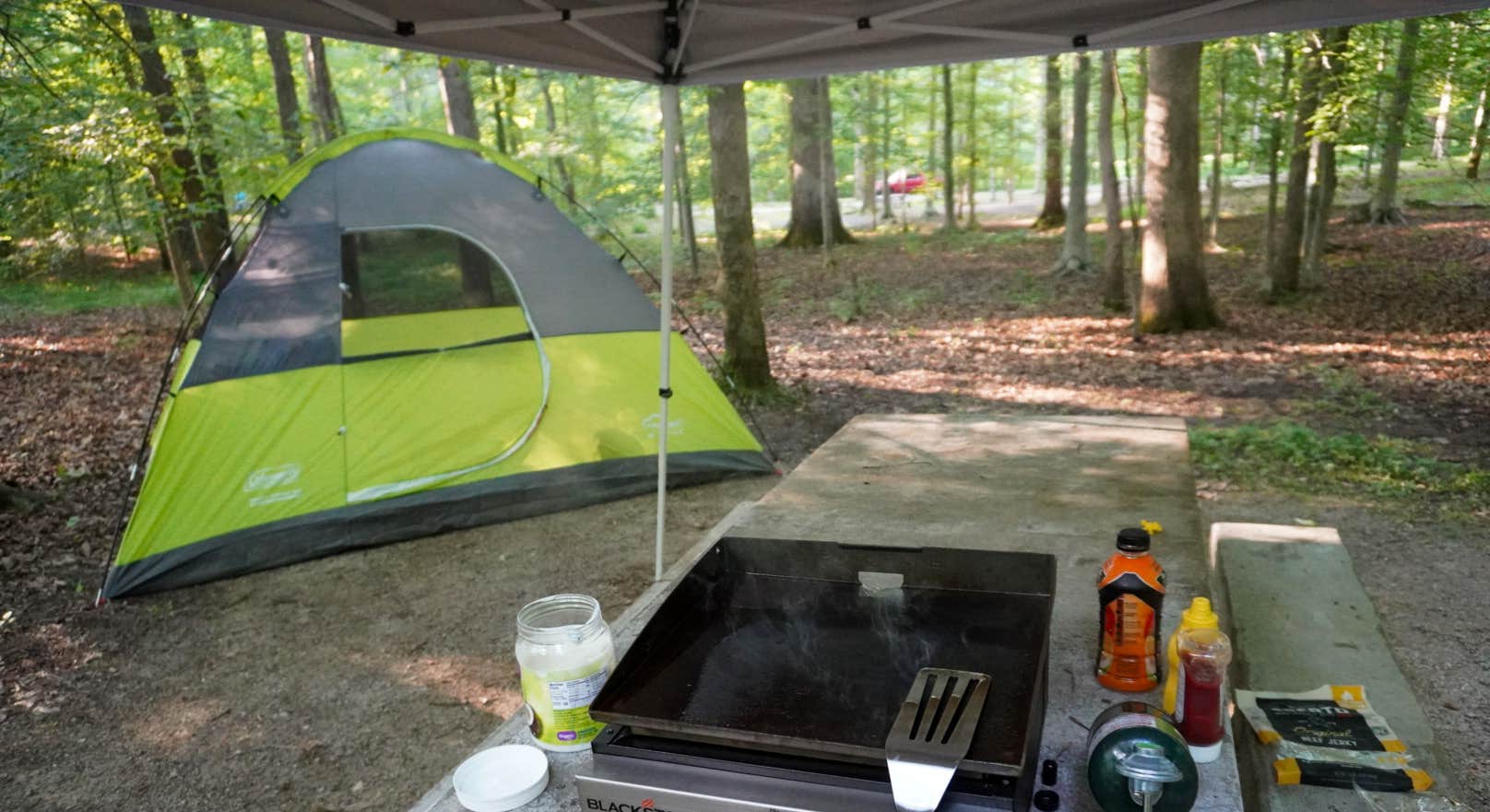 Photo by Jess B
Photo by Jess B
Responsible Camping Practices 
Leave No Trace in Mammoth Cave
Camping in this National Park means being a steward of both the surface and underground wilderness. Follow these Leave No Trace principles to keep Mammoth Cave pristine:
Plan and Prepare:
By reading this guide, you're already doing this one! Always camp in designated sites if available. Obtain cave tour tickets and permits in advance to avoid disappointment. Prepare for no cell service -- have maps and written directions. Planning extends to packing: bring resealable bags for trash, and perhaps a camp rug to minimize tracking mud (and cave dirt) everywhere.
Travel and Camp on Durable Surfaces:
Stick to established trails when hiking -- cutting switchbacks or forging new paths can cause erosion (especially since the ground is riddled with sinkholes and fragile soil crusts). At your campsite, set up your tent on the hardened pad or bare ground rather than trampling vegetation. In backcountry, choose sites that are already impacted (there are designated backcountry sites for this reason). Avoid enlarging sites or creating new fire rings -- use what's there.
Dispose of Waste Properly:
"Pack it in, pack it out" is the mantra. All trash, leftover food, and litter must leave with you. This includes small things like bottle caps, fruit peels, and bits of foil -- critters will try to eat anything. Use the dumpster at check-out rather than leaving trash in the campsite trash cans (raccoons have learned to raid those!). For human waste in the backcountry, bury it as described in the regulations section, and pack out toilet paper. If you see litter that others left, consider doing the park a favor and picking it up -- many campers on The Dyrt mention carrying an extra grocery bag to do a quick sweep of their site and trail.
Leave What You Find:
Mammoth Cave's surface may not have geysers or towering peaks, but it has delicate features like gypsum flowers in caves and historically significant artifacts. It's illegal to take ANYTHING from the caves -- even a small rock or old bottle. On the surface, leave wildflowers, bones, rocks, and antlers where they lie. Souvenirs should come from the gift shop, not the forest. One exception: If you spot trash or fishing line, you can "leave it better than you found it" by removing it, as that's not a natural part of the environment.
Minimize Campfire Impacts:
Campfires are a cherished part of camping, but use them responsibly. Keep fires small -- a flame no higher than knee-level is plenty for s'mores and warmth. Use only the provided fire rings or grills. Don't break branches off live or dead standing trees (collect dead wood from the ground if allowed, or use purchased wood). Before you leave or go to bed, drown the fire thoroughly with water, stir the ashes, and drown again until it's cool to the touch. Never leave a fire smoldering unattended -- Kentucky's woods can be dry and one stray ember could start a wildfire in the leaf litter.
Respect Wildlife:
Give animals space and quiet. Use binoculars or a zoom lens to observe rather than approaching closely. Keep your pet on a leash and do not allow it to chase or bark at wildlife. Secure all food as discussed so you don't habituate animals to human food -- for their safety and yours. If you encounter bats in the cave (you might see some roosting high on the ceiling), do not touch or disturb them -- white-nose syndrome has devastated bat populations, and they need all the help they can get to recover. At night, keep noise down so as not to disrupt the natural sounds of the park (and your neighbors' experience).
Be Considerate of Other Visitors:
Sound carries far in the campground and cave. Observe quiet hours and then some -- even during the day, excessive noise can diminish the park's tranquility. When on cave tours, follow the ranger's guidance about not using flash photography when not allowed, and try not to bump into others on narrow stairs. On hiking trails, those going uphill have the right of way (yield to them), and if you're biking, yield to hikers and horses. At scenic overlooks or narrow boardwalks (like River Styx Spring), take your time to enjoy but then allow others a turn. A bit of courtesy goes a long way -- remember many folks are here for peace, nature, and maybe to hear the drip of water in a silent cave passage or the hoot of an owl at night.
By following these practices, you ensure that Mammoth Cave National Park remains as magical and unmarred for the next generation of campers. Little actions -- picking up a micro-trash or giving a wide berth to a snake on the trail -- collectively make a huge difference. Rangers often comment that Mammoth Cave's visitors are among the most conscientious; keeping up that reputation is part of the legacy you can leave.
Frequently Asked Questions 
When are Mammoth Cave campgrounds open and closed? Mammoth Cave Campground (the main campground) is open from March 1 through late November (closing roughly around Thanksgiving). Maple Springs Group Campground follows a similar schedule (closing by end of October). Houchin Ferry Campground is open year-round. In winter, with the other campgrounds closed, Houchin Ferry operates first-come, first-served -- you self-register at the kiosk. Come spring (March), the reservation system kicks in again. Always check the park's website for exact dates each year, as maintenance or weather can affect opening/closing by a week or two.
Can I just show up and get a campsite without a reservation? During the off-season or on weekdays, you might snag a site, but in general for spring, summer, and fall weekends it's risky. All park campgrounds take reservations, and in peak summer, nearly every site is booked in advance. If you arrive without a reservation and the campgrounds are full, your best bet is to try nearby options: privately-run campgrounds (like Jellystone or local RV parks) or the Tailwater Campground by Nolin Lake (first-come sites are sometimes available there). In winter, Houchin Ferry's sites are usually available since visitation is low (but conditions are cold). It's always safer to reserve if you can. The park does release any unclaimed reserved sites by late evening to walk-ups (check at the visitor center or with a campground host), but this is far from guaranteed.
How much does it cost to camp in Mammoth Cave? For frontcountry campgrounds: Mammoth Cave Campground and Houchin Ferry are $25 and $20 per night respectively for a standard site (2025 rates). Maple Springs is $50 per night per group site. These prices cover up to 8 people (16 at group sites) and 2 vehicles. Discounts: holders of the America the Beautiful Senior or Access Pass get 50% off the federal campground fees (so $12.50 at Mammoth, $10 at Houchin) -- note this does not apply to the private campgrounds. Backcountry camping permits cost $10 per trip. Private campgrounds vary: Jellystone, for example, might run $55--$75 for full hookups, while state park or Corps of Engineers sites around the area range $20--$30. Overall, camping is the budget-friendly way to stay -- local motels in summer often exceed $100/night, so you'll save a bundle and wake up in nature to boot.
Are there RV hookups available in the park? Full hookups (water/electric/sewer) are not widely available in the park campgrounds. The only in-park hookups are two RV sites at Mammoth Cave Campground that have full hookups -- these are typically reserved for volunteers or are first-come in winter; general visitors usually cannot reserve those. Maple Springs has water and electric at all sites (since it caters to groups/RVs), but no sewer hookups or dump station there. Houchin Ferry has no hookups at all (tents only, and RVs aren't allowed due to road limitations). If you need full hookups for a larger RV, you'll want to stay outside the park -- Diamond Caverns RV Resort, Singing Hills RV, and Jellystone are examples of nearby RV camping near Mammoth Cave with full hookups. Mammoth Cave Campground does have a central dump station and potable water fill near the entrance that campers can use (free for registered campers). Generators are allowed at Mammoth Cave Campground in certain loops during daytime hours (8 AM -- 8 PM) but not at night, and they are prohibited at Houchin Ferry entirely (it's meant to stay quiet and primitive).
What's the "best" campground in Mammoth Cave National Park? It really depends on your priorities: If you want convenience to park activities and have a larger RV or need amenities, Mammoth Cave Campground is best -- you can walk to cave tours, enjoy flush toilets, and find a mix of tent and RV folks to socialize with. If you seek peace, space, and group camaraderie, Maple Springs wins -- it's often half-empty, very quiet at night, and excellent for groups or equestrians. If you're an adventurous tent camper who values nature and solitude over facilities, Houchin Ferry might become your favorite -- there's something magical about sitting by the river with just a few fellow campers and listening to owls and frogs at night. For families with kids or those who love activities, the Jellystone Park (private) just outside the park is often touted as the best (even though it's not NPS-run) because of the sheer fun factor and comfortable camping it provides. In short, there's no single "best" -- but reading through this guide (or The Dyrt reviews) with your preferences in mind should point you to your personal best option.
Are campfires allowed, and where do I get firewood? Yes, campfires are allowed in all designated campgrounds within the provided fire rings or grills. You cannot have open fires elsewhere (no random backcountry bonfires or ground fires). You can collect dead and down wood from the ground within the park for use in your campfire -- many campers at Houchin Ferry do this, as sticks and limbs are plentiful there. Do not cut any standing trees or remove wood from caves or historic sites. Firewood (as well as ice and basic supplies) is sold at the Caver's Camp Store near Mammoth Cave Campground. It's typically around $6--$7 per bundle. The store is open seasonally (spring through fall, with reduced hours in shoulder seasons). If you're coming in late, you might bring a bundle with you to start the first night's fire -- just ensure it's local, pest-free wood (the park prefers you buy within Kentucky or within 50 miles to prevent invasive insects). Some private campgrounds also sell wood to the public. Always fully extinguish your campfire before leaving it unattended or going to sleep -- douse, stir, douse. Remember that firewood cannot be taken out of the park -- burn it completely or leave unused wood in the fire ring for the next camper.
Do I need to worry about bears or other dangerous animals while camping? Mammoth Cave National Park is not known for bear activity -- unlike parks in the Smokies or out West, we have had no resident black bear population in recent history. On rare occasions, a wandering young black bear from eastern Kentucky might pass through the region, but it's highly unlikely you'd encounter one (and there are currently no special bear precautions required beyond normal food storage for raccoons). The more practical wildlife concerns are smaller: raccoons stealing food (very common if you leave it out), copperheads in woodpiles (watch your hands), ticks in the grass, and mosquitoes. Use the precautions we detailed for those critters, and you'll be fine. Venomous snake bites or aggressive animal incidents are extremely rare here. For general safety, keep your campsite clean (to deter any wildlife), never approach wildlife, and use a flashlight at night so you don't surprise any animals (or step on a snake). Also note: white-nose syndrome has drastically reduced bat numbers, so you might not see many bats -- but if camping at Houchin Ferry or near the river, you could see a few at dusk eating insects, which is a welcome sight!
What should I do about cave tour tickets -- reserve ahead or buy when I arrive? In summer and fall weekends, reserve them ahead of time online or by phone. Many cave tours, especially the popular Historic Tour and Great Onyx Lantern Tour, sell out days or weeks in advance. As a camper, you have the advantage of being right there and possibly picking up any last-minute openings or cancellations by checking at the visitor center first thing in the morning. However, if you have your heart set on specific tours or a tight schedule, definitely book online as soon as you know your dates. Spring and weekdays have more availability (and winter tours rarely sell out). You can reserve on Recreation.gov up to 6 months out -- similar to campsites. If you didn't reserve and arrive to find tours full, ask about the self-guided Mammoth Passage tour -- sometimes they have additional capacity for self-paced entry to part of the cave. Also, consider doing a surface hike with interpretive signs (like Cedar Sink or Sand Cave) as an alternative park experience if you can't get into a particular cave tour. But overall, to maximize your Mammoth Cave visit, we strongly advise reserving at least one cave tour in advance. After all, the caves are the star attraction -- and as a camper, you'll get to return to your tent under the stars after an incredible day underground. Those interested in glamping near Mammoth Cave National Park or cabin rentals near Mammoth Cave also have options for more upscale outdoor stays.
Is Mammoth Cave safe for kids and new campers? Absolutely -- Mammoth Cave is a very family-friendly park and a great place for those newer to camping. The developed campgrounds provide a controlled environment (bathrooms, water, help nearby if needed), and the cave tours are led by knowledgeable rangers on well-lit paths. Kids above 6 years old generally love the caves (younger children might be a bit nervous in the dark, but most do fine on short tours). The key is to keep an eye on children at all times in the cave (there are railings, but a youngster could wander) and around the camp (don't let them approach wildlife or stray into the woods alone at night). Introduce them to simple safety like not running on cave stairs and staying with the group. Around camp, use the trip as a learning opportunity -- let them help with setting up the tent, building (or at least supervising) the campfire, and looking at the night sky. Many first-time campers have created lifelong memories at Mammoth Cave. And if you forgot some essential or have questions, park staff and even fellow campers are usually happy to assist -- it's a welcoming community. So yes, it's a perfect place to start your family's camping tradition. For those curious about the park's legendary mysteries, check out this article on Mammoth Cave Sasquatch sightings or explore the connection between mythical beasts and national parks.
Planning Resources
Essential Mammoth Cave Links
- The Dyrt: Mammoth Cave Campground Search and Reviews -- Firsthand reviews and tips from fellow campers for both park campgrounds and private ones nearby.
- Kentucky National Parks and Monuments -- Learn more about Kentucky's other national parks and recreation areas.
- Mammoth Cave Camping Magazine Article -- Additional insights and camping tips for the area.
- Mammoth Cave National Park Official Website -- Latest conditions, maps, and park news. Check here for Green River Ferry status, trail closures, and program schedules.
- Recreation.gov -- Mammoth Cave Campgrounds -- Reserve Mammoth Cave, Maple Springs, or Houchin Ferry campsites, and backcountry permits. Also book cave tours under "Tours & Tickets" for Mammoth Cave.
- Mammoth Cave Area Cave Tours -- Descriptions of each cave tour, difficulty, and lengths. Great for choosing which tours fit your interests and abilities.
- Kentucky Fishing License Information -- Purchase fishing licenses online and read up on state regulations. Mammoth Cave lies in KY Wildlife Region 2.
- Local Outfitters -- Canoe/Kayak Rentals -- Green River Canoeing and Mammoth Cave Canoe & Kayak are two reputable outfitters providing boat rentals and shuttle service for river trips in the park.
- Mammoth Cave National Park Map & Guide (PDF) -- Available on the NPS site or at visitor center -- includes campground locations, trailheads, points of interest, and regulations summary in one handy document.
- Weather Forecast -- Mammoth Cave, KY -- Check the National Weather Service forecast for the park (Bowling Green KY is the closest point) before your trip. Summer thunderstorms and winter cold snaps will affect your packing list.
Mammoth Cave Reservation Timeline
Planning ahead can make the difference in getting your ideal campsite and tour. Here's a suggested timeline for reservations and prep:
| Time Frame | Task | Details |
|---|---|---|
| 6+ Months Before | Book Campground & Key Cave Tours | Recreation.gov opens sites 6 months out (to the date) -- reserve especially for June--August weekends Reserve must-do cave tours (e.g., Grand Avenue, Historic) as they also open 6 months ahead |
| 1--2 Months Before | Plan Other Activities | Reserve any private campground nights if needed (e.g., Jellystone) Book guided horseback rides or zipline tickets if interested (Cave City attractions) |
| 1--2 Weeks Before | Gear Check & Groceries | Do a test setup of tents/stoves at home; replace batteries Prepare a meal plan and grocery list for camp meals Check tour confirmations and print or save reservation QR codes |
| Day Before Trip | Final Prep | Check the weather forecast for Cave City, KY (pack extra rain gear or blankets as needed) Call Green River Ferry hotline (270-758-2166) if you planned to use the ferry, to confirm status Download offline maps for the area on your phone (cell service is spotty in park) |
| Arrival Day | Check In & Settle | Stop by Visitor Center for park newspaper, cave tour tickets (if not printed), and any last-minute questions Set up camp early so you have time to relax or explore near the campground before dark |
Mammoth Cave Camping Checklist
Use this checklist to ensure you have all essentials for camping and caving:
Reservations and Permits:
- Printed or downloaded campground reservation confirmation (or permit if backcountry)
- Cave tour tickets or confirmation emails (plus ID for ticket pickup if needed)
- National Park Pass or Entry Fee -- Not required here (park is free entry), but bring your Senior/Access Pass for campsite discount
- Kentucky fishing license (if you plan to fish)
- Backcountry camping permit (if overnighting beyond frontcountry campgrounds)
Camping Gear:
- Tent (with rainfly, stakes, guylines) and ground tarp/footprint
- Sleeping bags (rated appropriately for season) and sleeping pads
- Camping pillows or pillow cases (stuff with clothes)
- Headlamps/flashlights (one per person) with spare batteries
- Lantern or area light for camp (and fuel/batteries if needed)
- Camp chairs or seating
- Small broom/dustpan (handy for keeping tent and table clean of leaves and dirt)
Kitchen Items:
- Cooler (with ice or ice packs) -- pre-chill it if possible
- Camp stove and fuel canisters / propane
- Matches or lighter (in waterproof container)
- Cookware (pot, pan, coffee percolator if desired)
- Cooking utensils (spatula, ladle, tongs)
- Eating utensils (forks, knives, spoons), plates, bowls, and cups
- Cutting board and knife
- Biodegradable soap, scrubber sponge, and wash basin
- Trash bags (bring multiple -- separate out recyclables if you can)
- Paper towels / napkins
- Foil (great for fire-cooking packets) and resealable plastic bags/containers for leftovers
- Cooler-friendly foods and snacks (plan for no electricity)
- Water containers (jugs or hydration packs) -- potable water available at camp, but nice to have a gallon or two at site
Clothing:
- Comfortable hiking clothes (moisture-wicking shirts, convertible pants/shorts)
- Long pants and long-sleeve shirt (lightweight for bugs/sun, warmer ones for evening)
- Insulating layer (fleece or down jacket) for cool nights or cave chill
- Rain jacket or poncho; rain pants if you have them in spring
- Hat for sun (in summer) and beanie for warmth (in spring/fall)
- Sturdy closed-toe shoes (hiking boots or sneakers) -- required for cave tours
- Extra socks (nothing worse than wet feet; include some wool or thermal socks)
- Swimsuit (if you plan to swim or use a pool/shower facilities)
- Camp shoes or sandals (to wear around camp or to shower)
- Bandana or buff (handy for sweat, also doubles as eyeglass cloth, etc.)
Safety and First Aid:
- First aid kit (adhesive bandages, gauze, antiseptic, tweezers, moleskin, pain reliever, anti-itch cream, any personal meds)
- Insect repellent (preferably with DEET or Picaridin for ticks/mosquitoes)
- Sunscreen (for summer and fall -- the Kentucky sun can be strong)
- Whistle (each person, especially kids, can carry one -- three blasts is the universal distress call)
- Allergy meds or EpiPen (if anyone in your group has severe allergies -- bee stings, etc.)
- Hand sanitizer and/or moist towelettes (useful after cave tours where you touch railings)
- Headnet or thermacell (optional, for heavy mosquito areas)
- Bear spray -- not needed here for animals, but some folks bring pepper spray for personal safety (entirely optional; the park is generally very safe)
Navigation and Documents:
- Park map/brochure (free at visitor center, or print online ahead of time)
- Compass (and know how to use it -- mainly if going off the beaten path/backcountry)
- Guidebook or trail descriptions (if you plan detailed hikes)
- Flash drive or waterproof pouch for copies of important docs (IDs, medical info) -- not a must, but some like to have backups in case
- Emergency contact info card for each person (carry in wallet)
- Cash or small bills (camp store and some cave tours in person might need cash, plus for firewood at self-pay stations -- $1 and $5 bills useful)
By planning carefully, arriving with the right gear, and following park guidelines, you're set for an unforgettable camping adventure at Mammoth Cave. Picture ending your night by the campfire, listening to the chorus of crickets and katydids echoing through the woods. Come morning, you'll wake to mist over the Green River or sunlight filtering through the hardwoods, ready to delve into the subterranean wonders that make this park famous. Enjoy your trip -- and don't forget to wave hello to fellow campers and rangers you meet; the Mammoth Cave community is a friendly one, all brought together by the love of camping and caves. Happy caving and camping!

